Some clumping litter is bad for cats. Naturally clumping litters like corn can produce mold growth.
Breathing in clay and silica dust has been linked to respiratory issues in humans. And breathing wood dust can cause cancer.
These clumping litters are marketed as natural, but they can be bad for cats.
Cats are very clean creatures. They deserve a well-maintained bathroom just as much as you do.
You are picky about your toilet paper, cleaning sprays, and towels, right?
We should be just as picky about our cat’s litter.
Here’s the ultimate guide to every type of cat litter:
- Clay-based cat litters
- Silica gel crystal cat litter
- Wood and pine cat litters
- Recycled paper cat litter
- Corn cat litter
- Grass seed cat litter
- Wheat cat litter
- Coconut cat litter
- Hemp cat litter
- Tofu cat litter
- Walnut cat litter
- Cassava/Yuca cat litter
- Green Tea cat litter
- Bamboo cat litter
- Millet cat litter
I scooped hundreds of boxes over the years working with cats professionally. So I’ve seen it all!
Check out the guide today or pin the image below to your Litter Box board on Pinterest.

Disclaimer: I earn a commission if you purchase through affiliate links below. I only include affiliate links to litter products that I actually use. No additional cost to you.
1. Clay-based cat litters
Clumping clay-based litters are made from bentonite clay. Bentonite clay comes from volcanic ash. It is absorbent and can clump well.
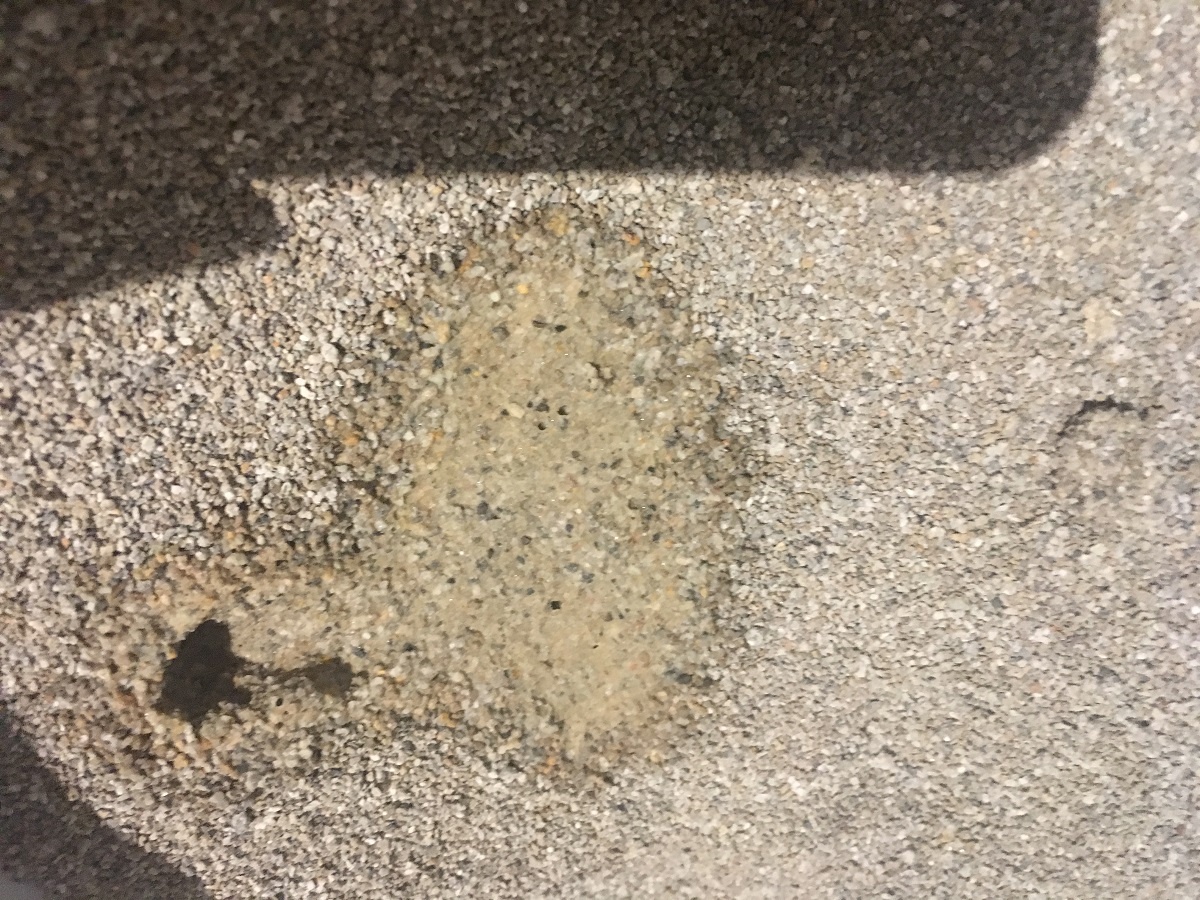
However, most of the time, these clumps become sludgy. This makes cleanup gross and difficult.
Sometimes the clumps don’t stay together well.
So you’ll get smaller clumps floating around in the litter box.
Why clay litter is bad for cats:
- Turns to sludge when it clumps
- Non-descriptive ingredients
- Very dusty, stinky, and heavy
- Breathing in clay can cause respiratory issues
Bentonite clay is very fine which means a lot of dust.
Inhaling bentonite can cause lung damage with increased exposure.
Clay is very fine, but it’s still heavy in weight. Again, not a very easy cleanup.
The non-clumping clay-based litters are made from other clay materials.
Most of the time the litter container will just say “contains clay products”. Not very specific with its ingredients.
This litter is non-biodegradable, and it has to be mined. So it is not great for the environment either.
Additionally, clay litter can expand and potentially cause urinary obstructions if your cat ingests it. Like when he grooms himself after using the box.
2. Silica gel crystal cat litter
This cat litter is made from silica gel beads.
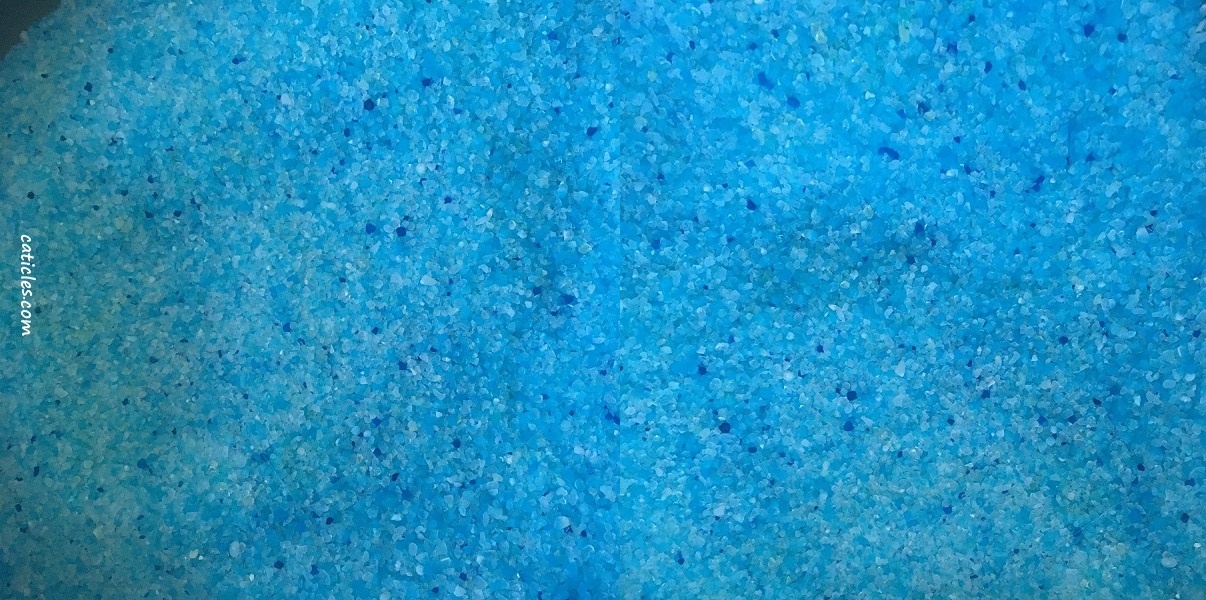
In humans, breathing in silica dust can cause a variety of health issues including Silicosis, lung cancer, and kidney disease.
Typically, this occurs after 15-20 years of exposure.
But cats are much smaller than us. And they breathe in cat litter multiple times a day, every day.
So that timeline is probably much shorter for them.
Why crystal litter is bad for cats:
- Non-clumping
- Hurts to step on
- Odor-absorbing chemicals
- Harmful to breathe and ingest
Crystal cat litter is typically non-clumping and essentially dust-free.
But since it is non-clumping, you have to mix the dirty urine around in the box.
If you don’t change this litter out regularly it will turn into sludge.
These crystals are quite large, and they hurt when you step on them.
I can’t imagine what it’s like for the cat’s small and sensitive paw pads.
Crystal cat litter is infused with odor-absorbing chemicals. These chemicals negatively impact human respiratory, endocrine, and immune health.
Why would it affect cat health differently?
3. Wood and pine cat litters
Pine-based litter comes in granules or pellets. The granules tend to be clumping, but the pellets are non-clumping.
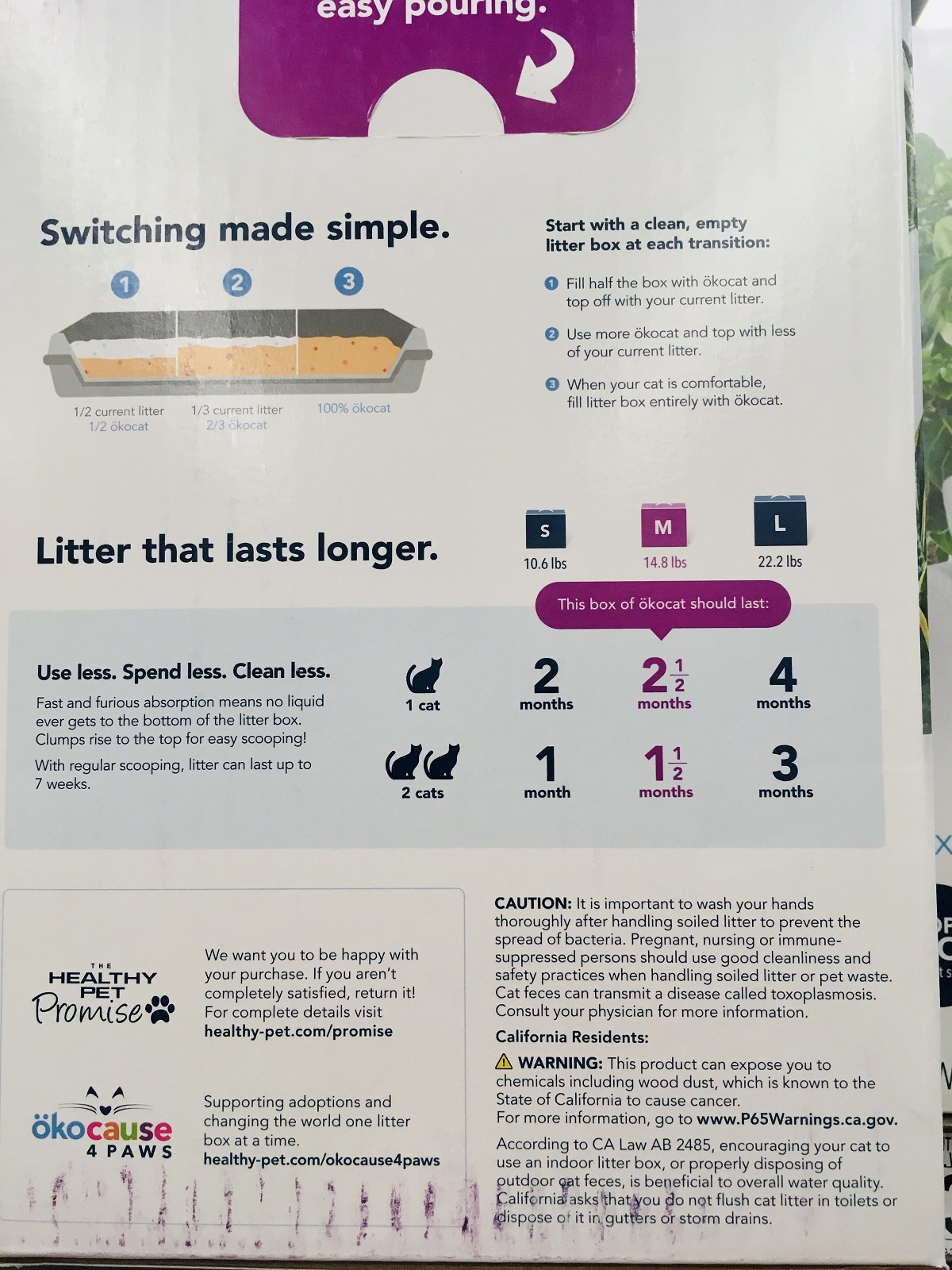
The pellets break down into a sawdust-like texture when moisture hits.
Why wood litter is bad for cats:
- Breathing in wood dust can cause cancer
- Non-clumping pellets turn to mush
You might think this is a good option because it’s recycled and natural.
However, breathing in wood dust is not safe for cats or humans.
Breathing in wood dust is known to the state of California to cause cancer (Proposition 65).
You’ll see this warning in fine print on the back of the litter box or bag.
Many people have said to me that this warning is used on “basically everything”.
But cats are in the box sniffing and digging around in that dust multiple times a day, every day.
Why take that chance?
Need a centralized place to keep track of everything related to your cat? Grab my Cat Care Binder Bundle!
4. Recycled paper cat litter
Paper litter is dust-free which is nice for you and your cat. This litter is available in pellet form and granules.
Same as pine, the granules clump, and the pellets do not clump.
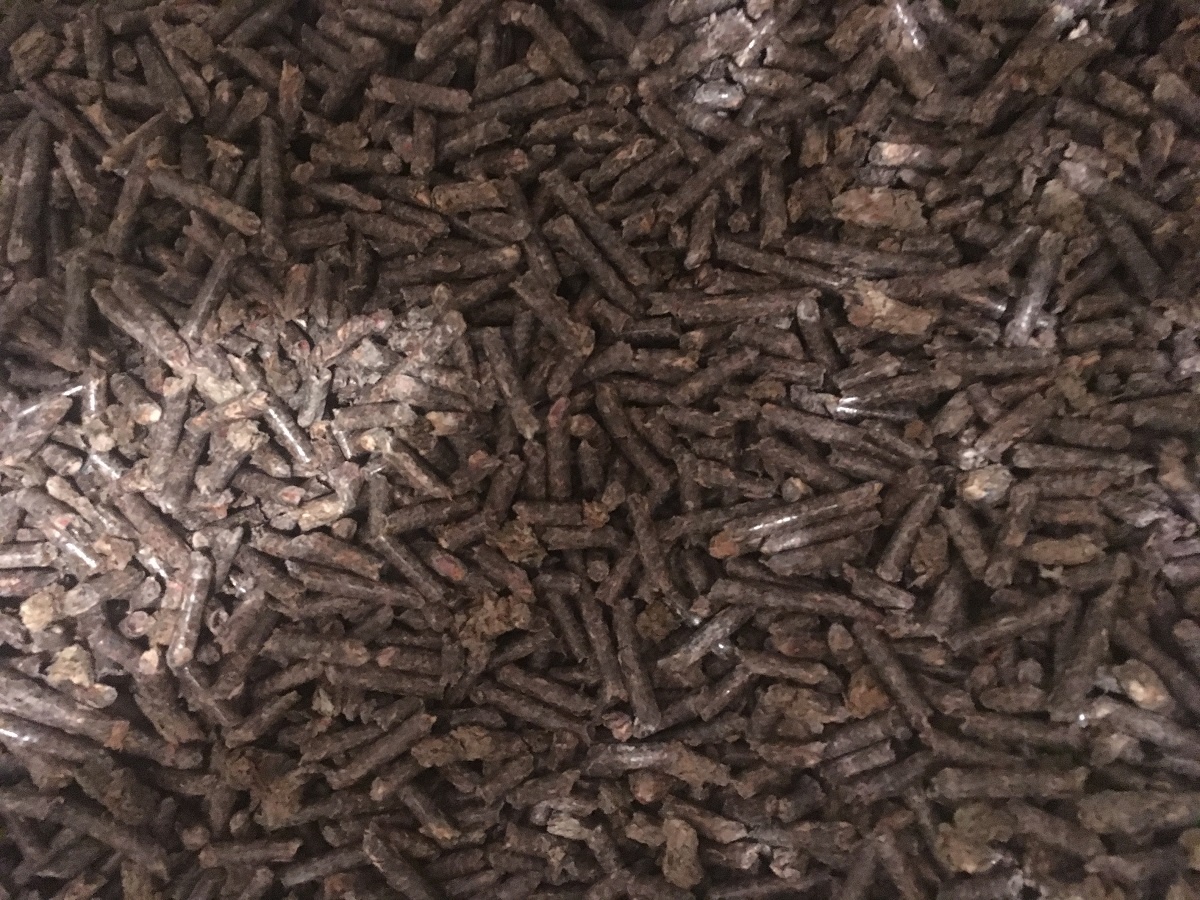
However, there’s no way to know where the paper comes from or how clean it is.
Did they use chemicals to strip the dyes?
Why paper litter is bad for cats:
- Paper turns goopy with moisture
- Cleanup is gross and annoying
- No way to know how dye is removed from paper
The non-clumping paper litter breaks down into a sawdust texture as moisture gets to it.
You must change this out more frequently if you choose the non-clumping litter.
This one isn’t too great because it isn’t similar to a cat’s natural bathroom.
Also, you don’t know what type of cleaning process they have in place to remove dyes and chemicals from the paper.
5. Corn cat litter
Corn-based cat litter clumps naturally because it is high in starch. This litter is made from corn cob granules.
It absorbs well and controls odor if you clean it regularly. It will stink if you don’t clean regularly.

These litters will boast that they are natural, but they are not. 92% of US corn crops are genetically engineered.
Why corn litter is bad for cats:
- Studies show that GE foods are dangerous
- Corn is at high risk for deadly mold
- Cats should not consume corn
The cat’s digestive system is not built to handle corn.
Your cat is likely to consume a bit of the litter since he cleans himself after using the box.
Corn-based litter can be very dusty and stinky if you don’t clean it often.
You also have to worry about deadly aflatoxin mold. This mold grows with a combination of starchy foods and moisture.
6. Grass seed cat litter
Grass seed litter is natural, it clumps, and most brands offer unscented.
This is the closest to the cat’s natural bathroom.
It was my favorite until…
A bag I received was infested with dead bugs.
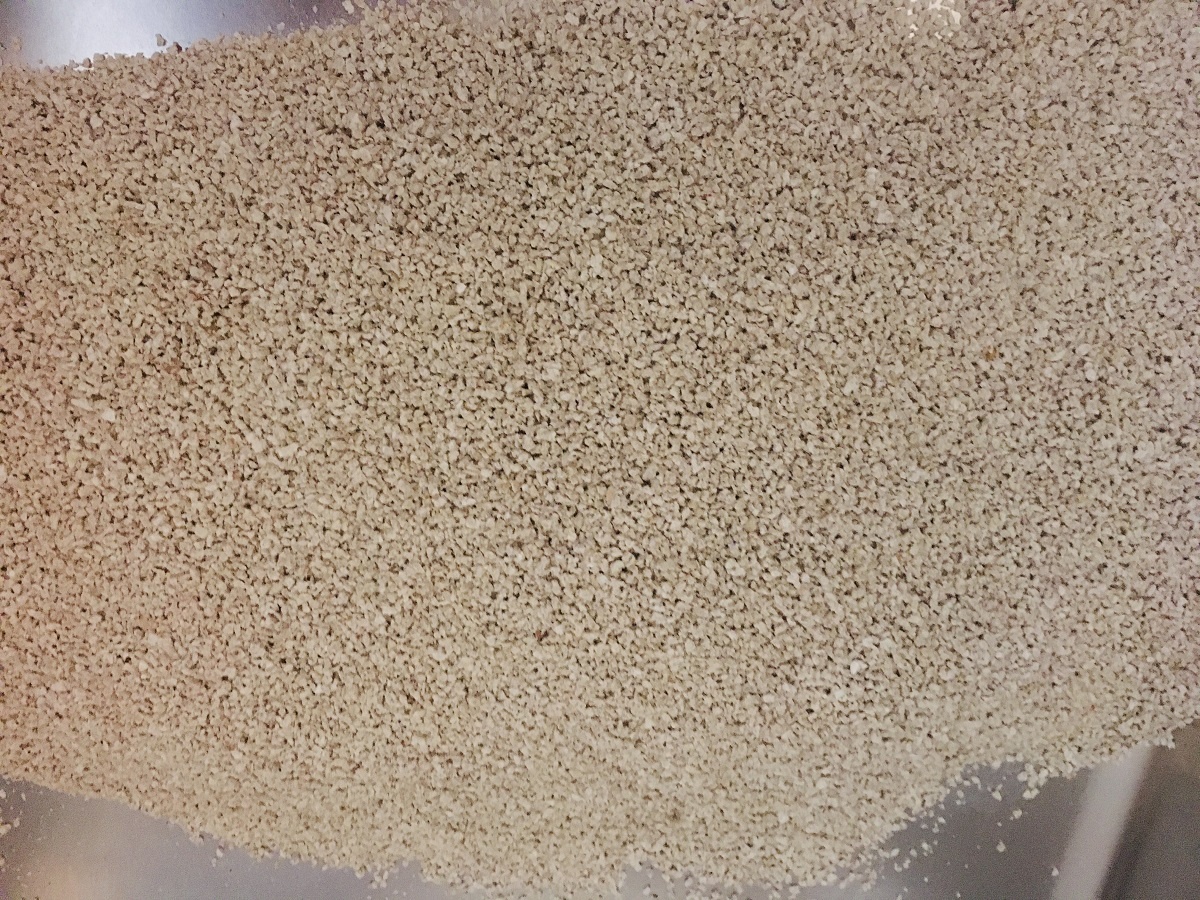
Unfortunately, I tried 3 different brands. And all of them were infested with dead bugs.
Additionally, grass seed is very starchy. This is what makes it clump. Starch and moisture combinations are at risk for deadly mold.
Why grass seed litter is bad for cats:
- May grow deadly aflatoxin mold
- No pesticides means your bag could be infested with dead bugs
- Dead bugs may be dangerous to ingest
The companies don’t use pesticides on grass. No pesticides are definitely a good thing.
But no pesticides could mean infested with bugs.
These dead bugs probably aren’t safe to ingest. Who knows what they are?
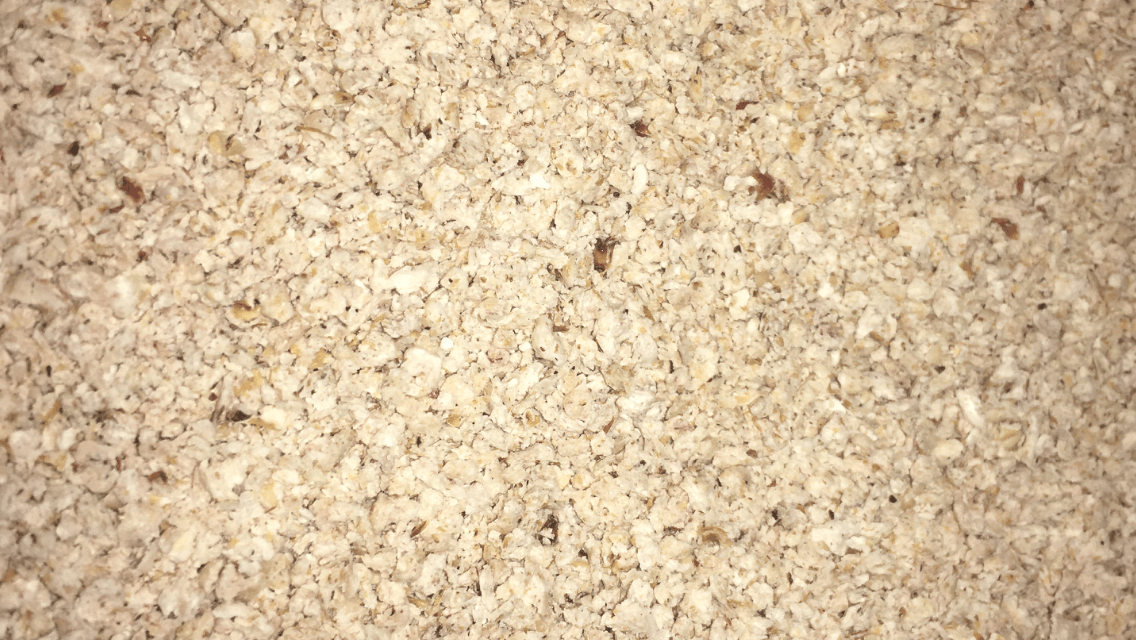
Grass seed litter has a sweet, almost cereal-like smell to it.
Honestly, this smell made me nauseous after some time of using it. And I scoop multiple times daily and clean out the box weekly.
I also noticed some mold growing on clumps that were in my DIY litter genie.
7. Wheat cat litter
Wheat is another clumping cat litter that boasts natural and biodegradable.
It clumps naturally. This litter claims it is dust-free. But I’ve scooped many boxes using wheat litter, and I’ve found it to be dusty.
This litter gets really stinky. And it cakes together and sticks to the bottom of the box if it isn’t cleaned regularly.
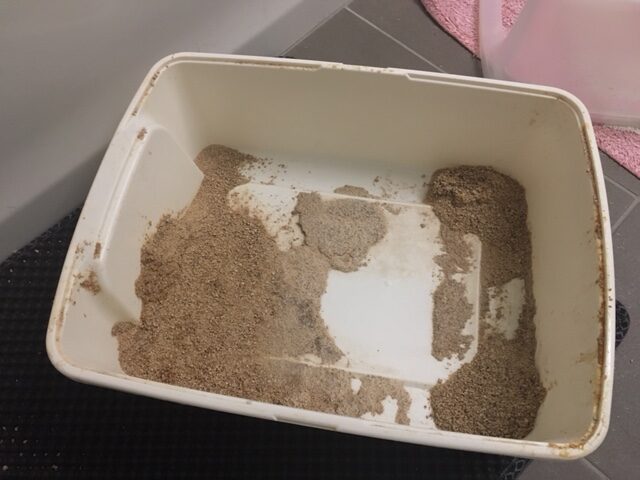
Why wheat litter is bad for cats:
- Dusty and clumps are stinky
- Cats should not ingest wheat
- Grains are at risk for deadly mold too
Cat digestive systems are not able to handle wheat, either. Ingesting wheat causes health issues.
In humans, wheat can cause inflammation. Why would it be different for carnivorous cats?
The ammonia smell from urine is really strong with this litter when it isn’t cleaned regularly.
Wheat is starch-based meaning it can also grow deadly mold.
8. Coconut cat litter
I tried coconut cat litter and really wanted to love it. But it was way too dusty.
Jericho’s paws were covered in dust every time he used the box.

CocoKitty coconut litter
I emailed CocoKitty about the dusty litter and sent pictures. They told me they are working on a new formula while trying to remain natural.
December 2021 update: CocoKitty’s warehouse experienced a terrible fire. Thankfully no one was hurt. However, their equipment was destroyed.
The only product available on their website is a pet mess cleanup product. Mostly used for spills, accidents, etc.
So it looks like they do not produce cat litter at the moment. But I will keep checking and updating because I want to use coconut litter!
October 2023 update: CocoKitty still doesn’t produce coconut cat litter.
CatSpot coconut litter
Next, I tried CatSpot clumping coconut cat litter. They sell non-clumping as well.
I emailed and asked how one can clump and the other doesn’t. Because both products say 100% coconut with no added clumping agents.
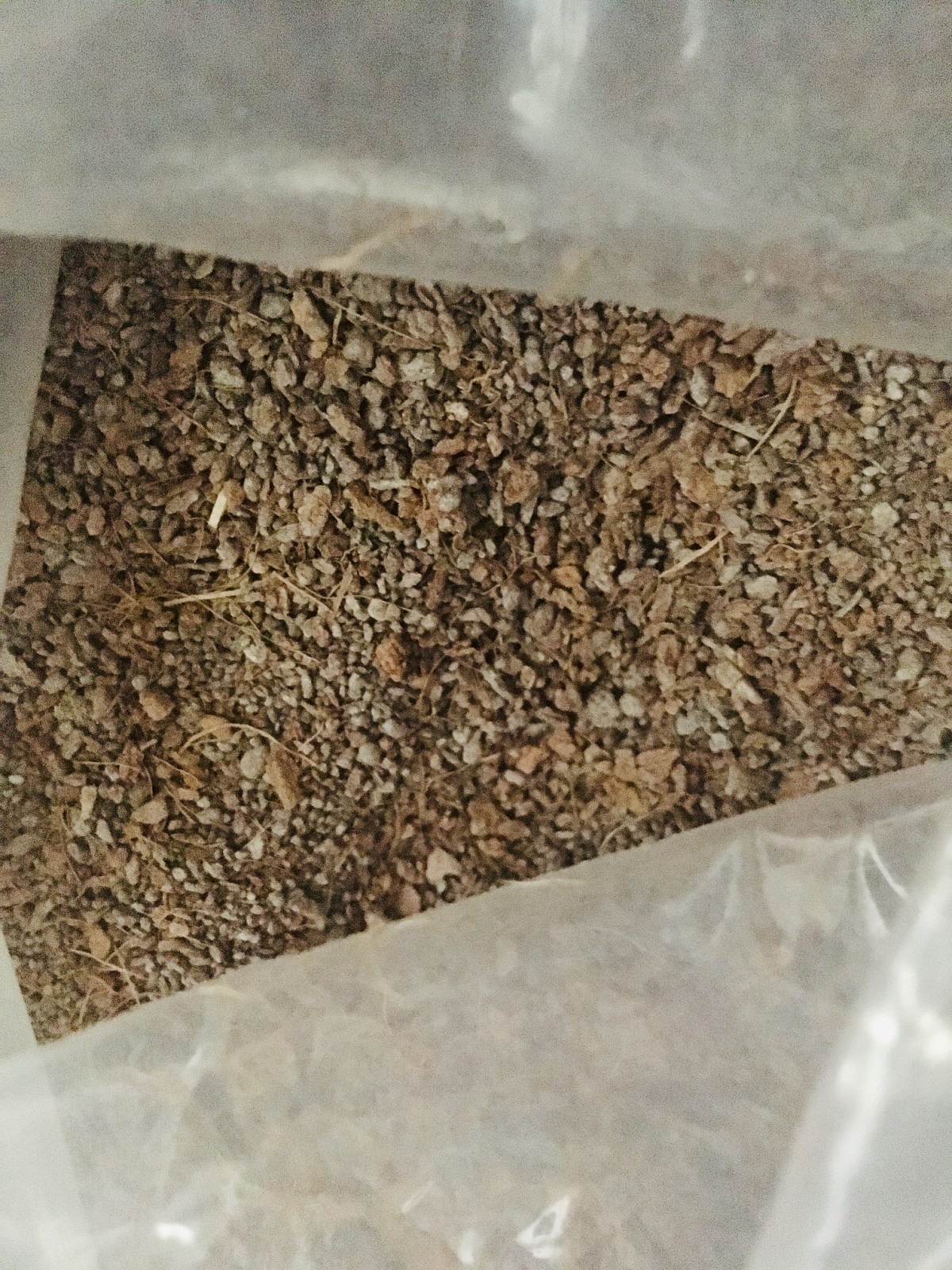
They emailed back and said the clumping coconut litter contains bentonite clay.
What?!
I asked them to change their website copy via email on May 26, 2020, and again via their online questions form in June 2020.
I submitted a review with the same explanation on July 29, 2020.
Guess what?
My review and question are not on the website. And their website copy still shows the same “no clay” claim. As of August 2021. EDIT: As of December 2021, they have removed “no clay”.
However, the website copy still says “Made 100% from Coconut”.
I also added another question on their website on August 20, 2021. Let’s see if that one gets published!
December 2021 update: My question is still not live on their website. I submitted another.
May 2022 update: My question didn’t go through on their website. And the copy says “no clumping agents”. This is a lie!! They add clay as a clumping agent! November 2022: website says the same thing – 100% coconut, no clumping agents.
October 2023: Website copy remains the same and my question/review was never posted.
Why CatSpot coconut litter is bad for cats:
- CatSpot clumping contains clay but claims it is 100% coconut with no added clumping agents
9. Hemp cat litter
I tried Oh! Farms hemp litter. It’s non-clumping, but they said it absorbs odors well.
It absorbs liquids well, but it does not clump or absorb odors.
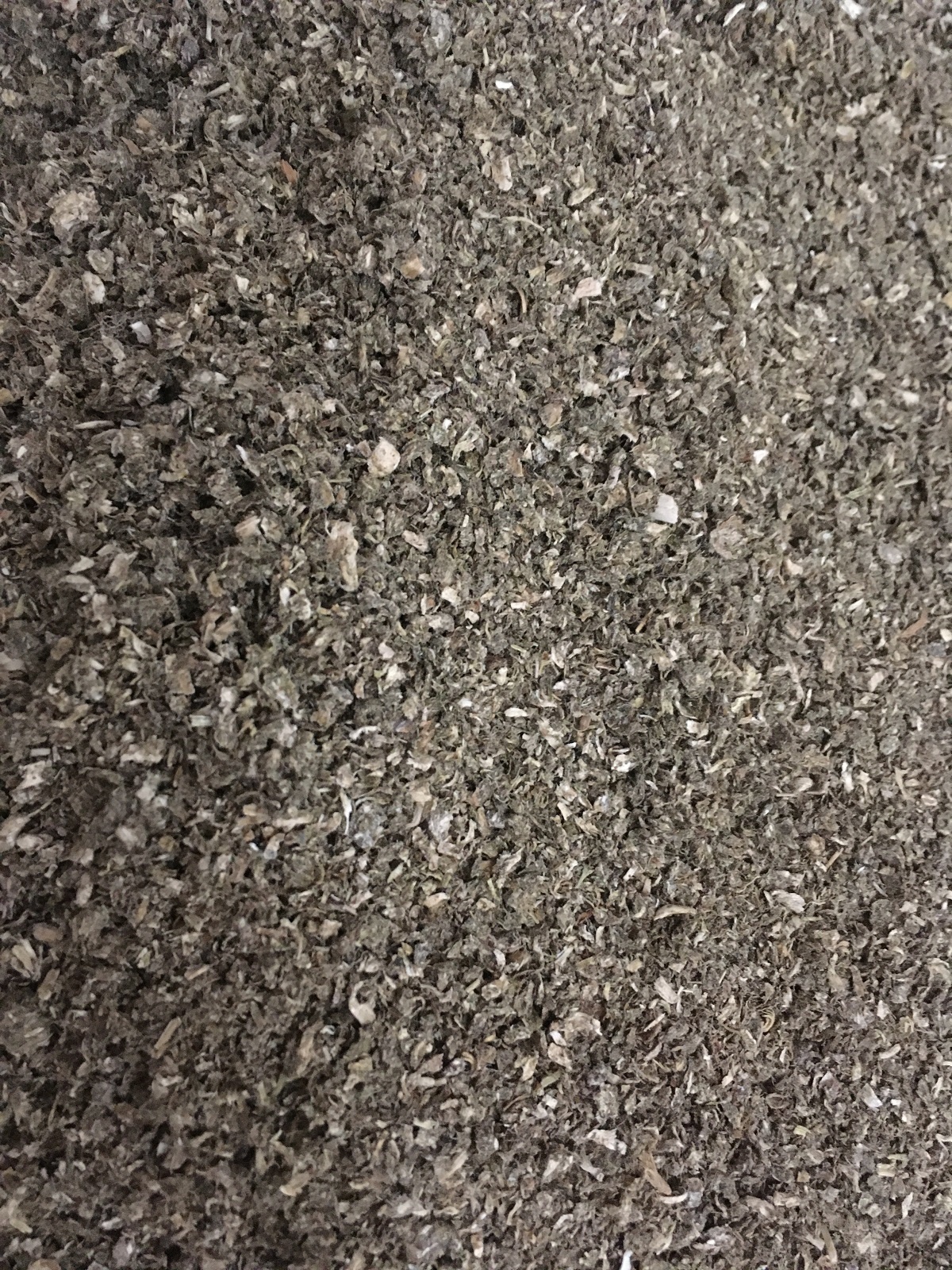
I adopted Jericho in 2017. I tried this litter in 2020. It was the first time I ever smelled ammonia in his litter box.
He was also reluctant to use it. Cats don’t like non-clumping litter.
Why hemp litter is bad for cats:
- It does not clump or absorb odors well
I also tried Hemp Sense cat litter. It says clumping, but unfortunately, it does not clump.
10. Tofu cat litter
My mother tried tofu cat litter. It comes in a pellet form.
It’s very dusty, and my mother said the cats refused the litter box with this litter.
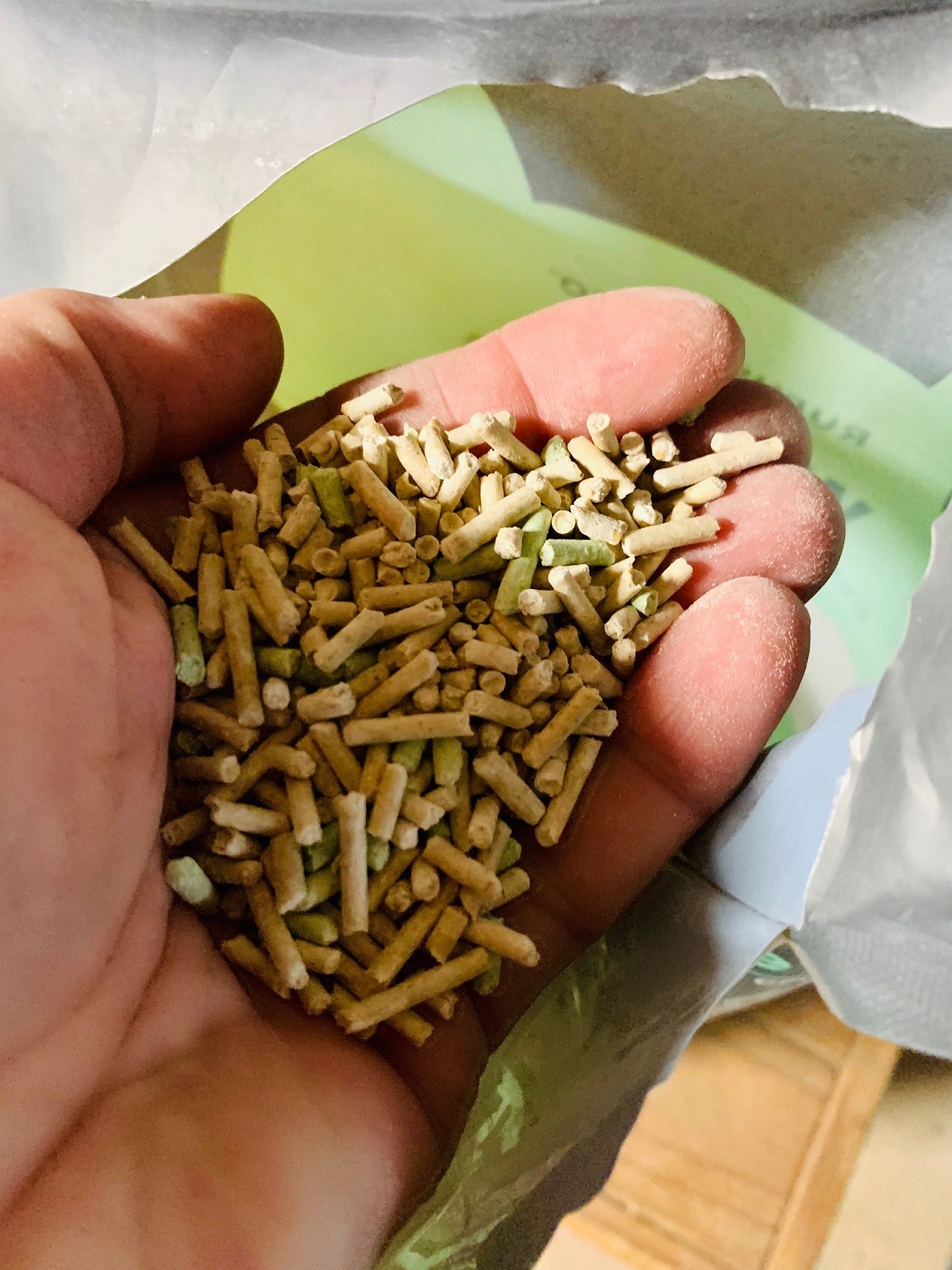
Why tofu litter is bad for cats:
- Dusty and hard on paws
- Cats should not consume soy
- Soy is not a natural product
Tofu is a product of soy. Over 90% of soy in the US is genetically engineered.
It’s marketed as natural, but it’s not.
Cats should not consume this unnatural product.
Many studies since the ’50s show that consuming soy poses dangerous risks.
11. Walnut cat litter
So far, I think Walnut-based litter is the best option we currently have. I am not 100% pleased with it. But it’s the best that we have.
Big emphasis on best option that we have.
I use Naturally Fresh.
They use US-grown walnut shells and a food-grade plant-based clumping agent. Their multi-cat litter option also contains an enzyme odor-blocker. I emailed them to get this information.
It says unscented, but there is a slight scent. It can be a bit dusty, especially at the bottom of the bag.
And the clump can break apart if you scoop too soon after your cat goes.
Obviously, it tracks. But all litter tracks.
Why walnut litter is the best we can do:
- US-grown walnut shells
- Food-grade clumping agents
- Natural enzyme odor-blocker
I’m saying this is the best option for now because I haven’t found dead bugs, it’s the safest option to breathe in and ingest, it’s unscented, and it clumps.
However, the risk of mold is still there. Any type of food mixed with moisture can grow mold.
But apparently, the nut itself is the issue with mold. Not the shells. Naturally Fresh uses the shells.
You can buy Naturally Fresh walnut litter online:
Other types of litter
In my research I’ve come across a few other litters:
- Cassava/Yuca
- Green Tea
- Bamboo
- Millet
I don’t have personal experience with these.
But here’s what my research has shown me about each…
12. Cassava/Yuca cat litter
Cassava is starch-based. So deadly mold is a risk here.
Note: I suppose the same mold is still a risk with walnut litter. So I am interested in how cassava/yuca compares. If you’ve tried this type of litter please let me know.
13. Green Tea cat litter
Most brands use wood as the base. Breathing in wood dust can cause cancer.
14. Bamboo cat litter
Bamboo is very high in silica. So breathing this in would not be good either.
15. Millet cat litter
I came across millet from a company that makes human-grade cat food.
Millet is starchy, and the litter description says it contains corn starch. So again, deadly mold risk.
FAQ
What’s the difference between clumping and nonclumping litter?
The difference between clumping and nonclumping litter is that one forms solid urine clumps and the other does not. Cats prefer naturally clumping litter because you can remove urine waste from the box easily. Nonclumping litter would be like swishing around waste in the toilet and not flushing. It’s important to remove waste from the litter box daily. Cats do not want to walk around on dirty litter.
Is clumping or non clumping cat litter better?
Cats prefer clumping litter so clumping cat litter is better than nonclumping cat litter. However, you must shop wisely and avoid clay, wheat, corn, crystal, and wood clumping litters. These clumping litters pose serious health risks to you and your cat. Breathing in these litters can cause respiratory issues, cancer, and starch-based litters are at risk for deadly mold.
What happens if a cat eats clumping cat litter?
If your cat is eating clumping litter you should seek help from your veterinarian. It might mean your cat has a nutritional deficiency. Cats and dogs seek out nutrition when they are lacking. Dogs may eat poop to get this nutrition, and cats may eat litter. Clay litter can expand and cause a blockage. And other food-based litters can grow deadly mold.
What litter is best for cats?
The best litter for cats is naturally clumping and unscented. You need to avoid litters with toxic clumping agents and fragrances because this will upset your cat. Most litters are not safe to breathe in or ingest. The best litter available, in my experience, is unscented clumping walnut litter. However, there are still risks involved if you do not clean the box regularly.
Check out my 5 min/week litter cleaning routine guide. Or watch the video below.
I also have some litter box hacks for you below.
Final thoughts on clumping cat litter
Unfortunately, in my experience, I haven’t found the absolute best cat litter.
Currently, I’m settling on walnut clumping litter.
Mold will always be a problem when moisture is involved.
But walnut litter is safe to breathe, ingest, and it clumps with food-grade agents.
Cats prefer naturally unscented clumping litter and a clean box.
So make sure you’re scooping after each use and cleaning the box weekly.
Need a centralized place to keep track of everything related to your cat? Grab my Cat Care Binder Bundle!

